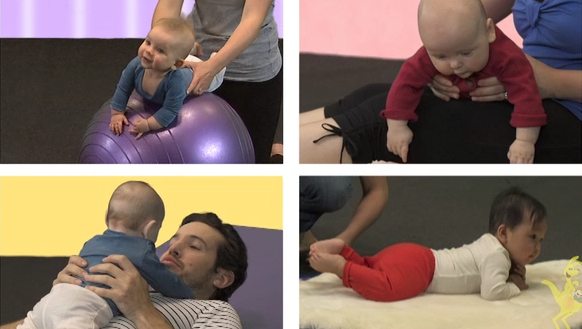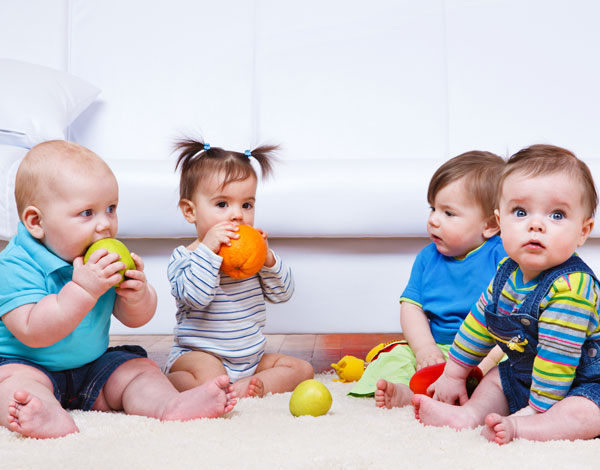Join the thousands of parents already raising smarter, happier babies with our online baby classes: The Active Babies Smart Kids series. Click here.
GymbaROO-KindyROO kids are excelling academically, emotionally, in leadership roles and on the sporting field. Find us at: GymbaROO-KindyROO
Dr Jane Williams and Bindy Cummings
Babies just love to move. We know this by watching babies who are frustrated by their immobility! Thinking they can assist children to be more mobile, many parents prop their babies up into a sitting position at a very early age. Yet, despite the best of intentions, this position can actually slow a baby’s pathway to mobility. Instead of making their muscles stronger and therefore able to propel them along, sitting actually has the opposite effect – it prevents the muscles needed for movement to be strengthened. So when should we allow our babies to sit and how do we encourage them to move without placing them into this more upright position?
Alice, five months old, is laying on her tummy closely watching her older three year old sister play with some brightly coloured toys that look and sound just great! “If only I could get my hands on those!” she thinks. But Alice is not yet moving and so she starts to whinge. Mum comes running in, props her upright using pillows and towels, places a toy in her hands and sees that she is happy. But is mum really doing Alice a favour by sitting her up?
In actual fact, Alice’s body is not yet developmentally ready to be sat upright. Alice will sit herself up when her brain and body are ready. Once she has developed adequate muscle and balance control – usually around six to eight months of age (of course some babies are earlier and others later) – she will sit herself upright without help.
Being able to sit upright usually occurs after muscle strength in a baby’s legs, arms, shoulders and back through tummy crawling is well developed and her brain has matured to a point where important reflexes that aid in the healthy development of balance, posture, movement and stability are present.
The normal sequence of baby development follows this order: rolling, pivoting, pushing backwards and lurching forward, moving forward on tummies, leading to tummy crawling then creeping. It is at approximately the same time that a baby gets herself into the creeping position on her hands and knees that she will push herself back to sit. So, developmentally, babies don’t need to sit until they are just about to creep/crawl.
Sitting early may interfere with this natural progression of skills, each of which plays an important role in later learning and development. For example, sitting early generally results in less tummy time for a baby. This means less movement and strengthening experiences and less opportunity to develop important reflexes that allow Alice to crawl, creep and to sit safely and maintain a strong upright posture, without falling and banging her head. Before Alice can sit up, she must accomplish mastery of head control and be able to automatically adjust the position in which her head is held in response to movement. This enables the healthy development of balance, the smooth control of the muscles of the eyes and development of visual perception. Control of the head is gained in tummy position much more quickly than in any other position.
The Bumbo, other ‘baby seats’ and walkers should be avoided all together. A baby who is forced into a sitting position under six months of age, such as in the leg hugging, bottom securing ‘Bumbo’ chair, will not be able to move freely in this device and will be denied opportunities to develop the muscle strength necessary for crawling and creeping.
So, there is no need to be in a hurry for your baby to sit. Nature will determine the timing. For now, simply help your little one to develop a brain and body ready for movement and sitting by providing the right environment:
- Lots of tummy time – helps develop head control, visual fixation and tracking skills. If your baby is sitting and not creeping/crawling, try to encourage more tummy time. This could be tricky if your baby is able to sit themselves up without your help, as they will just keep doing this! Don’t stress, but when the opportunity arises, encourage tummy time by playing lots of tummy games. GymbaROO’s free online video full of tummy time ideas here.

- Vestibular stimulation – rocking, rolling, spinning, dancing, moving; aids in the maturation of the balance organs and help with the development of a good posture. Access GymbaROO-KindyROO’s online video full of vestibular ideas for babies here.
- Massage – stimulates blood supply to the muscles of the body and helps development of muscle tone which is important for smooth and coordinated movement. Access GymbaROO-KindyROO’s online video on baby massage here.
- If feeding solids before your baby is able to sit themselves in an upright position, paediatricians advise you to have your baby in a position where there is good head support. “Baby should be in a slightly reclined position and should be able to keep her head up while leaning back. Good head control is essential to prevent choking.”1 When feeding solids, young babies who are artificially propped to sit when they do not yet have good head control can drop their heads forward as their spine curves. This is actually more dangerous than the semi-reclined position. If your baby has severe colic or reflux and needs to be propped more upright while feeding it is best done in the safety of a parents arms where instant response to potential choking can be taken. The plastic moulded ‘baby seats’ do not support the upper body in young babies who do not have the strength to hold themselves up, so is not a suitable substitute.
- Avoid any ‘baby seats’ that are marketed to keep non-sitting babies in a sitting position. For more on these so called ‘baby seats’ read here: ‘The Bumbo, ‘baby seat’ devices and propping your baby to sit. Please avoid.
- Give lots of love and hugs – the most nourishing environment for healthy brain development.
- For hundreds more fun and loving ideas and activities to help your baby’s development, come join our GymbaROO-KindyROO classes and/or watch our online series of baby classes: Active Babies Smart Kids, for parents and babies, (Australia and New Zealand only). It is highly recommended by doctors, paediatricians, early childhood experts and the Maternal Child and Family Health Nurses Association.
Dr Jane Williams (PhD, BMgt, RN(Paeds)) is the Research and Education General Manager for GymbaROO and KindyROO. Dr Williams is one of Australia’s leading experts on baby and child development. More on Dr Williams here.
Bindy Cummings (B.Ed(Human Movement) Hons) has worked as a teacher, child development consultant, early childhood development lecturer, teacher trainer and INPP & iLS consultant. She is the co-creator of GymbaROO’s Active Babies Smart Kids online series, has authored many published articles on child development. She is working on the content and development GymbaROO’s portal and online training programs, and the creation of new online programs for parents and children. More on Bindy Cummings here.
References: 1. http://www.nywestsidepeds.com/r12.html
GymbaROO-KindyROO
Thousands of parents, babies and children are presently involved in our programs and creating rising stars. GymbaROO-KindyROO kids are excelling academically, emotionally, in leadership roles and on the sporting field. Come join all the fun and learning! “GymbaROO – The best decision I ever made for my child.” Classes from 6 weeks old – 7 years GymbaROO KindyROO
Active Babies Smart Kids – Online Baby Classes
GymbaROO-KindyROO’s online series of baby classes is taking the parenting world by storm! It is highly recommended by doctors, paediatricians, early childhood experts and the Maternal Child and Family Health Nurses Association. This series is being called: “The essential guide for parents”. Join the thousands of parents already playing with their babies from birth, in the best way for brain and body development and laying crucial foundations for future learning. What happens in the first year, not only matters, it matters a lot!
Active Babies Smart Kids BabyROO series – Click here.
Try the first class FREE! Click here to watch our Active Babies Smart Kids Episode 1 – Tummy Time
Enjoy the following GymbaROO-KindyROO articles
GymbaROO-KindyROO: Who, what, where, why and how
All about GymbaROO-KindyROO’s online baby classes for parents and babies: Active Babies Smart Kids
How to raise a smarter, happier baby
Why active babies make smart kids
Become a GymbaROO-KindyROO franchisee
Positioning baby to prevent a flattened head shape.
Baby milestones: A journey, not a race.
Tummy time for baby’s healthy development.
An important warning for all parents of babies.
Why creeping and crawling matter.
Click here for more GymbaROO-KindyROO article choices



